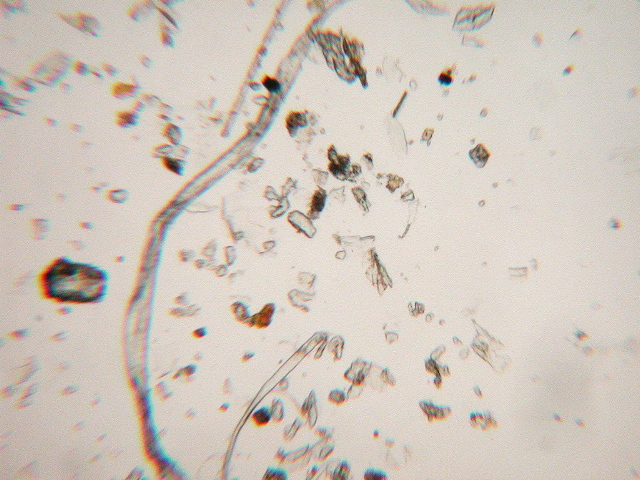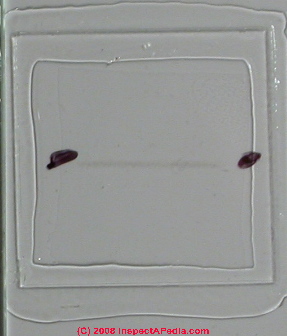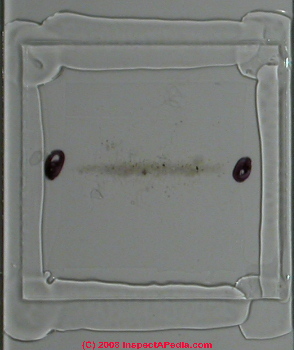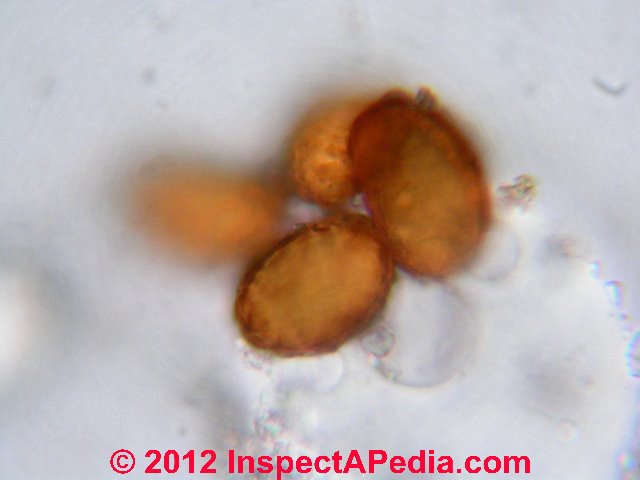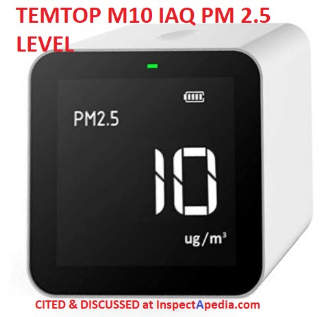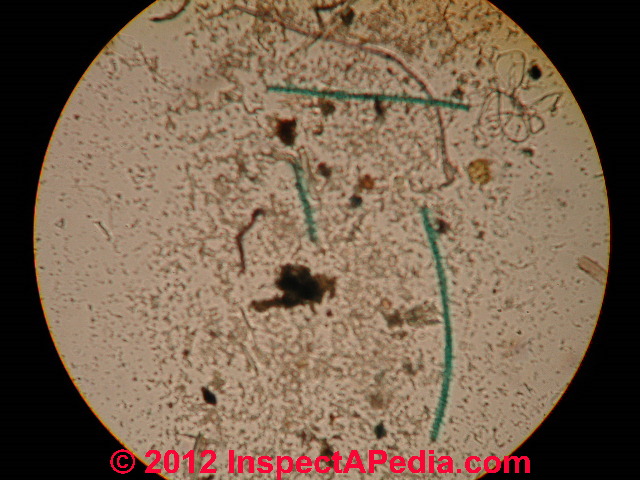 Airborne Particle Calculations
Airborne Particle Calculations
How to calculate airborne particle concentrations
for mold, particulates, PM-2.5, PM-10,
IAQ Test Laboratory SOPs
- POST a QUESTION or COMMENT about computing the count of particles per cubic meter of air - indoor air quality and mold test lab procedures. Questions & answers about how to calculate airborne mold or other airborne particle levels expressed as n particles per cubic meter of air
How to calculate airborne mold or other airborne particle levels.
How to Convert Particle Mass Measurements in mg/M3 to Particle Count Measurements for PM 2.5 & Other Sizes
This document describes proper procedures for evaluating mold and other aerobiological samples for purposes of identification of environmental sample contents and to help in assessing potential exposure of building occupants to levels of indoor particles, mold, allergens, and other materials.
Included are procedures for proper particle counting from air samples, lab chemistry for sample preparation, and a directory of field sampling practices and methodology.
References are also given for particle identification. This is Daniel Friedman's general aerobiology & forensic procedure. Other mold test laboratories & forensic laboratories follow similar procedures but details and policy may vary. For clarity, some topics are addressed in separate documents listed here.
InspectAPedia tolerates no conflicts of interest. We have no relationship with advertisers, products, or services discussed at this website.
- Daniel Friedman, Publisher/Editor/Author - See WHO ARE WE?
How A Mold Lab or Forensic Lab Calculates Airborne Particle Concentration Levels
Example % of Trace Calculations for an Olympus CH-2 microscope #5F0837
To form an accurate understanding of the percentage of particle trace that has been examined in the microscope we need to know the physical area of the particle trace and the physical area encompassed by one field of view in the microscope for a given microscope objective (e.g. 40x or 100x objective).
[The actual magnification in the field of view is the product of the microscope objective magnification and the microscope eyepiece magnification. Typically the eyepiece magnification is 10x or 15x.
Typical microscope objective magnifications used for aerobiology, mold particles, pollen, and other small particle identification and counting are 40x, 60x, 100x or 120x.
Indeed while counting is faster and easier at the lower magnifications of 40x or 60x, only by going to 100x oil immersion can we reliably see and count small particles in the 1-5u range, such as Penicillium or Aspergillus spores.
Air Sampling Equipment Trace Dimensions
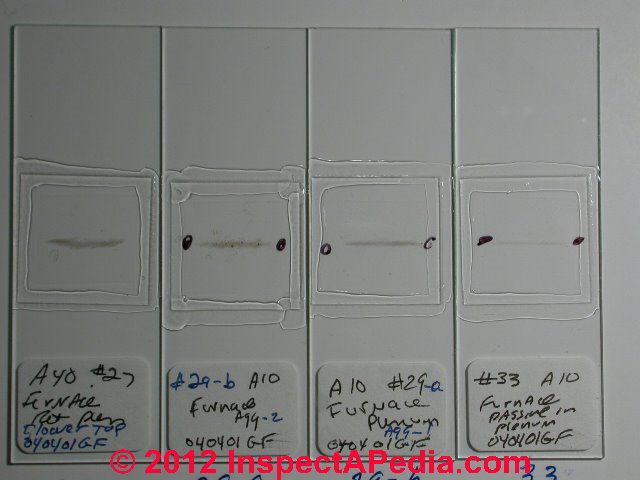 If we are counting less than 100 percent of the particle trace, the dimensions of the trace width and length are required to complete airborne particle
concentration calculations.
If we are counting less than 100 percent of the particle trace, the dimensions of the trace width and length are required to complete airborne particle
concentration calculations.
While we give the standardized particle trace dimensions and the percentage represented by one pass across the trace at different magnifications (below), keep in mind that the true particle trace on an air sampler slide varies due to site conditions and other factors - as you can see in our example photo at left.
See LAB & FIELD IAQ EQUIPMENT SOP for a complete table of airborne particle trace dimensions for various air sampling devices.
Air-O-Cell @1000x: .173mm field width/14.4mm x 100 = 1.2% of trace per pass
Air-O-Cell @ 400x:.44mm/14.4mm x 100 = 3.05% of trace per pass
Burkard @ 1000x: .173mm/14.0mm x 100 = 1.24% of trace per pass
Burkard @ 400x: .44mm/14.0mm x 100 = 3.14% of trace per pass
Allergenco @ 1000x: .173mm/.145mm x 100 = 1.193% of trace per pass
Allergenco @ 400x: .44mm/.145mm x 100 = 3.03% of trace per pass (e.g. use .303 as divisor in formula below)
(WARNING: this data is calibrated for a particular microscope in our lab. This number must be calibrated to the microscope, and optics used for the examination of the trace).
A Detailed Example for Airborne Particle Concentration Counting Calculations using the Allergenco Time-Lapse Impaction Sampler
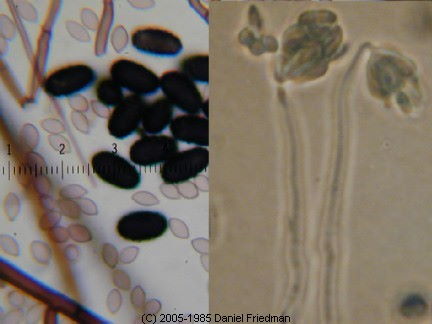 To compute the airborne concentration of any individual particle (or of all particles) in an air test sample we need to know the air sample volume (total liters), for which we need to know the air sampling device flow rate in liters per minute and the number of minutes the sampler was run.
To compute the airborne concentration of any individual particle (or of all particles) in an air test sample we need to know the air sample volume (total liters), for which we need to know the air sampling device flow rate in liters per minute and the number of minutes the sampler was run.
We also need to allow for cases in which we count less than 100 percent of the particle trace. The basic formula for calculating the airborne particle concentration in an air sample is
Particles/M3 = [ 1000 liters per cubic meter / liters of air sampled ] x [Raw particle count / % of particle trace examined]
1. Sample Volume in Liters = (Sampler run time in minutes x calibrated sampler flow rate in LPM)
One M3 is 1000 cubic liters. So another version of the calculation could use
2. Sample Volume in M3 = [(Flow rate in
LPM)/1000] x [run time in minutes]
(or if you prefer, 15 lpm=.015 M3/m )
To obtain the total volume of air that was processed during an air test for airborne particles we multiply the air flow rate of the sampler (e.g. 15 lpm) by the number of minutes the sampler was operated (e.g. 3 minutes).
E.g. if we ran our Burkard Personal Air Sampler for 7 minutes, knowing that this devices pulls air through its impaction sampler slit at 10 liters per minute, 10 x 7 = 70 liters of air in our sample.
3. Percentage of the total particle trace that was examined.
As we explain below, very dense or overloaded samples may have so many particles as to preclude an accurate count of 100 % of the trace sample. If we are counting less than 100% of the sample we need to include that factor in our calculations.
Trace length counted = (Microscope field diam.) x (# cross-width traverses)
4. Particles / M3 = (raw particle count / % portion of trace counted) x (1000L/M3 / sample volume in L)
Example 1 - Number of particles represented by a 10 minute air test using an Allergenco impaction sampler
if an Allergenco time-lapse impaction air sampler is run for 10 minutes, 150 L was sampled (10 minutes x 15 LPM)
For the Allergenco, 1 cross trace pass at 1000x = 1.193% of trace
For the Allergenco, 10 cross-trace passes = 11.93% of the trace, or .1193 of the trace.
Example: If Particle "x" was counted at 653 particles in 10 passes of the trace at 1000x.
Example: if 100% of the trace was counted, then the "raw count" will be divided by 1 (100%)
[653 particles / (.1193 of trace/pass )] x [1000 L in 1 M3 of air / 150 L in sample] = 34,490.6 particles/M3 of air in the sample. This number should be documented in the lab as 34,490.6 but in an interpretation may be described as 34,500 particles/M3 of air.
Airborne particle concentration is found to be 34,500 particles/M3 of air.
Example 2 - Airborne mold concentration represented by an 8 minute air test using a Burkard Personal Sampler
The Burkard PAS samples air at 10 lpm, so an 8-minute sample represents a test volume of (10 x 8) = 80 liters of air.
We counted 100% of the particle sample trace in this case, identifying the number of occurrences of each particle type found in the sample. Using just one of these particles, Alternaria sp., we found 7 Alternaria spores in the entire trace.
Particles / M3 = (raw particle count / % portion of trace counted) x (1000L/M3 / sample volume in L)
Alternaria mold spores / M3 = ( 7 / 1.00 ) x ( 1000L/M3 / 80L ) = 88 Alternaria mold spores / M3
An Alternative count procedure for Airborne Particle Concentrations - Fourths Method
Measure the actual trace length. Divide the trace into equal segments by 4ths
Count 1 segment completely, selecting a representative segment after scanning lengthwise the whole trace.
Multiply the actual count by the number of segments (4) to get the "trace total count. ["trace total count"] x [1000/sample volume] = particles/M3
General Counting Rules for Airborne Mold or Other Particle Concentrations in Air Tests & Samples
Interferences in Reaching the Objective of 100% Trace Counting - handling overloaded air particle samples
For low density particle traces it is easy and reasonable, as well as most accurate, to count 100% of the particle trace area.
Where practical, in our lab we count 100% of the particle trace on the sampling slide or cassette.
Our photo (left) illustrates a reasonable-density air particle sample trace on a slide from one of our Burkard Personal Air Sampler devices.
By examination using the naked eye the trace density appears not to be overloaded, though final decision on how to process this sample will be made after the initial examination in the microscope.
This particle sample was collected inside the return air plenum of a heating & air conditioning air handler, using passive air sampling methods - we just placed the sampler in the space and ran it for a number of minutes, with minimum disturbance to the environment.
And of course the equipment was OFF during the test.
But some airborne particle or dust vacuum particle traces are so dense with particles that an accurate particle count can be difficult, impractical, or even impossible.
Our second Burkard PAS particle trace (below left) was collected in the same location as the first particle trace above, but we used our standard "aggressive" sampling method intended to dislodge local particles that might otherwise not appear in the test.
We rapped once with a flashlight on the side of the air handler's air plenum chamber.
You can (photo below) see that this approach made an enormous difference in the number of particles collected even though we ran the air sampling device for the same time interval as in the first test.
This sample is probably overloaded. "Overloaded" is a critical problem as it means that particles are stacked atop one another in the sample, making an accurate particle count just about impossible.
For example, a very dense particle trace suggests that during the latter portion of the air sampling period, late-arriving particles may impact particles already on the trace medium surface rather than contacting the more sticky trace capture media.
As a result, the particle bounce rate increases late in the air sampling period - such particles are lost and thus under-represented in the trace result.
For thick, occluded, dense particle traces too, the absolute number or raw particle count could be in the thousands, making accurate manual counting inaccurate or infeasible.
For such dense particle traces our minimum objective is to count 25% of the trace. 20% may be used in the most difficult cases.
We first scan the entire particle trace at lower magnification, perhaps 400x, in order to note the presence or absence of anomalies such as voids in the trace capture media or thick clusters of particles or large particles that can substantially affect the accurate particle count number and that might be missed during a 25% random trace area count approach.
Particle or mold spore cluster or spore chain counting & reporting rules
Believe it or not some mold test labs count the four spores seen at left as "one" particle because they occur in a single cluster. It's not. There are four individual mold spores in that cluster, though not all in equally-sharp focus. An experienced forensic microscopist, knowing that her depth of field is more flattened at higher magnifications, is constantly turning that microscope focus knob up and down to see what's really in the sample.
Similarly, and more important, some mold test labs count a chain of connected mold spores such as Aspergillus spores or Penicillium spores as "one" spore.
Inconsistencies in how labs count clusters and chains of particles can make a very large difference in the airborne particle concentration reported.
We count the individual spores in clusters or chains, and we use that number in our airborne particle concentration calculations.
But because the presence of Pen/Asp spores in chains in an indoor air sample screening for building mold contamination is very important, we also report the presence of spores in chains as a separate technical examination.
Airborne Particle Trace Count Stopping Rules
Airborne Particle Trace Count Stopping Rules may be considered. (when 200 particles/M3 are reached continue that pass across the particle trace to completion, record the total count, calculate the total based on % of trace read, and express it as a minimum with citation of stopping rule.)
IAQ Investigation and Airborne Mold or Particle Level Reporting requirements
See MOLD LAB REPORTS.
Also see ACCURACY vs PRECISION of MEASUREMENTS where we argue that measurements should be reported to include their percentage of error or a +/- figure to give a realistic understanding of the actual reliability of the data.
Indoor Air Quality Sampling Equipment Calibration Procedures
Also see the following forensic lab & microscopy equipment calibration and adjustment details in these individual lab equipment procedures notebook or policy documents, including the latest microscope calibration dates.
- Procedures Microscopy Count Calibrate ™ directory including Trace calculations recap.doc (this file in non-html form)
- Procedures Lab SOP Chemistry ™ directory Lab SOP - @LAB SOP.doc
- Procedures Field ™ directory @SampMeth.doc (field method descriptions, comparisons) including bulksamp.htm (client-submitted tape sample procedure) and IAQMethods.htm (equipment lists) and see LAB & FIELD IAQ EQUIPMENT SOP for notes on air sampling equipment calibration.
- Particle Identification ™ directory (disk library and reference texts in lab)
- See AIR QUALITY STUDY San Miguel de Allende for a description of use of the PurpleAir PM II - a laser counter device for continuous air sampling and counting of airborne particulates
Microscope calibration:
Review microscope setup, Kohler illumination, objective centering, stage micrometer calibration of eyepiece reticule scale, and other preparation procedures in the lab notebook dedicated to each microscope.
See LAB PROCEDURES MICROSCOPE TECHNIQUES for a discussion of microscope adjustment, setup, and calibration procedures. For each microscope (or other equipment) the lab maintains a procedures manual that gives these details as well as records of calibration and adjustment dates and results.
- Olympus Microscope Operation
- Polam Microscope Operation
- Stereo Microscope Operation
- Projecting Microscope Operation
- Olympus-CH-2.xls
- Polam Optics.xls
Review objective/eyepiece field width measurement data at spread sheet dedicated to each microscope
Lab Chemicals for Particle Sample Examination
Review list of chemicals, uses, preparations in the Lab Procedures
™ Chemistry & Slide Preparation notebook.
Review the MSDS for each lab
chemical in the Lab Supplies MSDS notebook. Key files:
- MICROSCOPE SLIDE PREPARATION
- LAB PROCEDURES MICROSCOPE TECHNIQUES
- TECHNICAL & LAB PROCEDURES
- @LABChemicals.doc
- @slide preparation.doc
- Meltmount tips.doc - also at MICROSCOPE SLIDE PREP - PERMANENT MOUNTS
- Other files in directory Procedures Lab SOP Chemistry
Procedures for Qualitative Building Surface Particle Sample Analysis or Vacuum Sample Analysis for Surfaces, Carpets, Soft Goods
Tape or vacuum cassette (tape, Air-o-Cell, or filter cassette) samples are prepared using lab SOP for each sample type. Qualitative analysis and characterization is described in each lab report. Quantitative analysis of surface tape samples is highly questionable since particle density across a building surface cannot be assumed to be uniform.
For Air-o-Cell or MCE filter cassettes, scan the entire trace at low magnification, 40x or 100x, for consistency and for unusual particle clusters to be considered in selecting areas for cross-scans.
For tape samples, the sample may be examined using the low-power stereo microscope to evaluate sample consistency and to select a sample tape segment most-likely to contain significant particles. A 1 cm segment is selected for analysis. If the tape appears to contain a variety of particles by texture, color, etc., multiple 1-cm segments may be required for analysis.
Scan across the trace beginning at one end of the selected area, to and from areas where no particle are visible while crossing the trace. See separate counting rules and stopping rules (if any stopping rules are to be applied), obtaining raw counts of significant or other particles of interest in each pass and totaling for the trace.
See Particle Counts.xls for worksheets used for this purpose. The worksheet automates particles/M3 of air when the raw counts and volume of the sample are entered.
How to interpret mg/M3 airborne PM2.5 measurements vs PM2.5 Particle Counts
I have a reading of 0.18 mg/m3 on my Temtop model 10 and am wondering if this is a high reading for health concerns? - Anonymous by private email 2020/03/28
[Click to enlarge any image]
Reply: convert particle PM 2.5 "counts" in mg/M3 into PM 2.5 particle count levels?
Thanks for an important question that needs some clarification. Your "IAQ" monitor is using a laser counter to count small airborne particles in the 2.5 micron range and also an electrochemical sensor to measure formaldehyde levels in air.
There are two models: The P10 model only detects PNM 2.5 while the M10 (your model) measures PM2.5 and HCHO (formaldehyde), TVOC (total VOCs), and "AQI" an air quality index.
Bottom line: **IF** you are reading PM 2.5 (not HCHO) on your Temtop M10, then the 0.18 mg/m3 shown is **at the moment or time of display** well below current exposure limits for particles in the PM2.5 range.
But without more information about the device, which display you are seeing, and how, over what time interval the measurement is made, the number may need some further interpretation.
Watch out: be sure that you are reading your Temtop M10 Air Quality Monitor display correctly.
For example, in the illustration above the Temtop P10 Air Quality Monitor for PM2.5 is showing a PM 2.5 particle level of 10 ug/m3 of air, that's 10 micrograms of particulate matter per cubic meter of air.
In the product image shown below, the M10 is showing HCHO 0.04 mg/m3 - that is ten milligrams of HCHO per cubic meter of air.
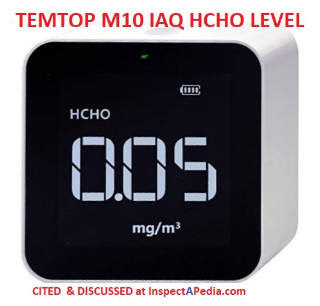 That is a concentration of VOCs (volatile organic compounds) in air, NOT an airborne particle count. Notice also that below the display is in milligrams per cubic meter whereas above the pm2.5 count is expressed in micrograms per cubic meter of air.
That is a concentration of VOCs (volatile organic compounds) in air, NOT an airborne particle count. Notice also that below the display is in milligrams per cubic meter whereas above the pm2.5 count is expressed in micrograms per cubic meter of air.
Really? Actually the device is measuring formaldehyde (HCHO) level, not necessarily other VOCs.
"Electrochemical sensor uses the electrochemistry theory in order to get a more accurate detection results for formaldehyde molecules in the air." - op. cit.
And it is not feasible - at easy not so easy - to convert a PM2.5 particle measurement expressed in total mass per cubic meter of air into an actual physical particle PM2.5 particulate count
like that we give at AIRBORNE PARTICLE COUNT LIVE DATA SAN MIGUEL de ALLENDE
without knowing quite a bit more about how your device works and about the actual particles being detected - I'll elaborate on this below.
The manufacturer says: "Temtop 3rd generation laser particle sensor combined with unique particle swarm optimization algorithm makes particle measurement more accurate and stable."
So it seems to be giving a sort of running average. If you don't have it, for the Temtop M10 Air Quality Monitor for PM2.5 HCHO TVOC AQI Professional Electrochemical Sensor Detector Real Time Display Rechargeable Battery here are the
- Temtop M10 AIR QUALITY MONITOR MANUAL [PDF] Elitch Technology, Inc., 1551 McCarthy Blvd., Suite 1112, Milpitas CA 95035 USA Email: sales@temtopus.com Website: www.temtopus.com Made in China.
- Temtop M10 & Other INSTRUMENTS BROCHURE [PDF] op. cit.
Fine particulate matter (PM2.5) is an air pollutant that is a concern for people's health when levels in air are high. PM2.5 are tiny particles in the air that reduce visibility and cause the air to appear hazy when levels are elevated. - this article from NY State's DOH is helpful: https://www.health.ny.gov/environmental/indoors/air/pmq_a.htm
Continuing from that source:
The short-term standard (24-hour or daily average) is 35 micrograms per cubic meter of air (µg/m3) and the long-term standard (annual average) is 12 µg/m3. A microgram is a unit of weight. There are a million micrograms in a gram, and a pound is equal to about 450 grams.
So PMnn is a count of the numbers of particles in air per cubic meter.
Example: a PM 2.5 of 51-100: Air quality is acceptable; however, if people are exposed to air with particles at this level for 24 hours there may be a moderate health concern for a very small number of people who are unusually sensitive to air pollution.
Your Temtop M10 Air Quality Monitor for PM2.5 is giving a reading of 0.18 mg/m3 - that's a total volume of material expressed by weight in milligrams, NOT a particle count. In my OPINION it's not particularly useful as without more information we don't know if that is actually a total weight of particles each of which was 2.5 two and one half microns or less in width or if it's something else. We need to find and review the product literature.
The World Health Organization (WHO) 2005 airborne particle exposure guideline limits (aimed to achieve the lowest concentrations of PM possible) are.
PM2.5 Exposure Guideline - WHO
- 10 μg/m3 annual mean
- 25 μg/m3 24-hour mean
PM10 Exposure Guideline - WHO
- 20 μg/m3 annual mean
- 50 μg/m3 24-hour mean
You cannot simply convert these total particle mass values (like 10 μg/m3) to particle counts without knowing the particle size and shape.
You also cannot make sense of the total particle mass value given by your IAQ monitor without having considered the exposure duration;
Also relevant is the distribution of level particles in the air over time. A single concentration burst has different potential health effects than a uniformly-distributed distribution of particles in air over time.
In the real world outdoors and even in most indoor environments particles are never distributed in air uniformly over time.
How to Convert Particle Mass Measurements in mg/M3 to Particle Count Measurements for PM 2.5 & Other Sizes
Here is a researchgate comment that's helpful:
... there is one approximation to that conversion. You need to know the density of the particles and then ASSUME a shape, particle size distribution, and porosity of the particles. The easier way is to assume a spherical solid shape (porosity =0).
With the diameter from the particle counter (which depends on the refractive index of the material of the particulates, if you are using a laser based counter) you can obtain the volume of each particle or group of particles.
With the density you can convert this volume to mass, and finally you can obtain the concentration in micrograms per cubic meter by dividing the mass obtained by the volume sampled by the counter. Again this method is approximated because you are assuming the shape, the porosity and the particle size distribution.
There is other method to obtain a better approximation, but that will require the use of a Surface Area and Porosity analyzer (such as the Metromeritics ASAP 2020 Surface Area and Porosimetry Analyzer, which uses chemisorption) - Juan Carlos Ramirez-Dorronsoro, Marietta College - retrieved 2020/03/28 original source: https://www.researchgate.net/post/Can_anyone_provide_information_on_how_to_convert_particle_count_per_cubic_meter_to_microgramme_per_cubic_meter2
...
Reader Comments, Questions & Answers About The Article Above
Below you will find questions and answers previously posted on this page at its page bottom reader comment box.
Reader Q&A - also see RECOMMENDED ARTICLES & FAQs
Question: how do I remove all the bad airborne particles that are making me sick?
I've tried many different approaches in removing some sort of airborne particles that has invaded my vehicle and has multiplied in every apartment i've lived.
This happens to be number three since March 2015 where i was exposed to many fungus spores one is black toxic mold according to experts report.
Need help with removal. I've seen all kingdoms. now what's next,being the host? Occasionally i feel them up and down my back. 2015/10/24 colleen
Reply: removing 100% of airborne particles is not normally possible nor should it be our objective.
Colleen:
You cannot remove all airborne particles unless you live in a building or room similar to a computer "clean room" with very extensive air filtering and positive interior air pressure - particles occur in outdoor air; IF there is a problem with high levels of unsafe indoor air particles one needs to find and remove the source, such as mold contamination on drywall due to building leaks.
About what you feel on your back, start with a consult with your doctor.
Ask her if your complaint is likely to have an environmental cause.
Find a doctor whom you trust and listen to her advice.
...
Continue reading at AIRBORNE PARTICLE & MOLD COUNT NUMBER GUIDE or select a topic from the closely-related articles below, or see the complete ARTICLE INDEX.
Or see these
Recommended Articles
- ACCURACY OF AIR TESTS for MOLD
- AIR POLLUTANTS, COMMON INDOOR
- AIR QUALITY STUDY San Miguel de Allende
- AIRBORNE MOLD SPORE COUNT GUIDE - home
- AIRBORNE PARTICLE LEVELS vs IAQ - home
- AIRBORNE PARTICLE ANALYSIS METHODS
- AIRBORNE PARTICLE COUNT VARIATION CAUSES
- AIRBORNE PARTICLE COUNT VARIATION EXTENT
- AIRBORNE PARTICLE COUNTS in DUCTWORK
- AIRBORNE PARTICLE COUNTS vs SAMPLER HEIGHT
- AIRBORNE PARTICLE COUNTS vs WINDOWS, DOORS
- AIRBORNE PARTICLE & MOLD LEVELS in DUCTWORK
- AIRBORNE PARTICLE & MOLD TEST ACCURACY
- AIRBORNE PARTICLE SAMPLING USES
- AIRBORNE PARTICLE SIZE DEFINITIONS & TYPES
- AIRBORNE PARTICLE SIZE TABLE
- AIRBORNE PARTICLES in INDOOR AIR, CHART
- FORENSIC INVESTIGATION of BUILDINGS
- FORENSIC LAB TECHNICAL PROCEDURES - home
- INDOOR AIR QUALITY METHODS COMPARED
- LAB PROCEDURES MICROSCOPE TECHNIQUES
- LAB & FIELD IAQ EQUIPMENT SOP
- MICROMETEORITES in ROOF DUST
- MICROSCOPE SLIDE BULK SAMPLE PREP
- VACUUM CASSETTE FILTER SAMPLE TESTS for DUST / MOLD
Suggested citation for this web page
AIRBORNE PARTICLE ANALYSIS METHODS at InspectApedia.com - online encyclopedia of building & environmental inspection, testing, diagnosis, repair, & problem prevention advice.
Or see this
INDEX to RELATED ARTICLES: ARTICLE INDEX to BUILDING FORENSICS
Or use the SEARCH BOX found below to Ask a Question or Search InspectApedia
Ask a Question or Search InspectApedia
Try the search box just below, or if you prefer, post a question or comment in the Comments box below and we will respond promptly.
Search the InspectApedia website
Note: appearance of your Comment below may be delayed: if your comment contains an image, photograph, web link, or text that looks to the software as if it might be a web link, your posting will appear after it has been approved by a moderator. Apologies for the delay.
Only one image can be added per comment but you can post as many comments, and therefore images, as you like.
You will not receive a notification when a response to your question has been posted.
Please bookmark this page to make it easy for you to check back for our response.
IF above you see "Comment Form is loading comments..." then COMMENT BOX - countable.ca / bawkbox.com IS NOT WORKING.
In any case you are welcome to send an email directly to us at InspectApedia.com at editor@inspectApedia.com
We'll reply to you directly. Please help us help you by noting, in your email, the URL of the InspectApedia page where you wanted to comment.
Citations & References
In addition to any citations in the article above, a full list is available on request.
- [6] US EPA, PARTICULATE MATTER SAMPLING [PDF] ATPI 435: Atmospheric Sampling Course, U.S. EPA, retrieved 9/9/12, original source: epa.gov/apti/Materials/APTI 435 student/Student Manual/Chapter_4_noTOC-cover_MRpf.pdf
- [8] For most-recent microscope optical measurements: field width data and calibration see: Olympus-CH-2.xls & Polam Optics.xls Calibration is repeated no less than when an objective is removed/replaced or other microscope optical or stage components are removed/replaced, or if a new technician is employed.
- For most-recent calculations of % of trace represented by n cross-scans see: Particle Counts.xls
- For automated calculations of particles or spores per cubic meter of air (spores/M3) from raw airborne particle counts see: @SporeCountWork.xls
- For spore count worksheets see: sheet 2 of @SporeCountWork.xls
- Our recommended books about building & mechanical systems design, inspection, problem diagnosis, and repair, and about indoor environment and IAQ testing, diagnosis, and cleanup are at the InspectAPedia Bookstore. Also see our Book Reviews - InspectAPedia.
- In addition to citations & references found in this article, see the research citations given at the end of the related articles found at our suggested
CONTINUE READING or RECOMMENDED ARTICLES.
- Carson, Dunlop & Associates Ltd., 120 Carlton Street Suite 407, Toronto ON M5A 4K2. Tel: (416) 964-9415 1-800-268-7070 Email: info@carsondunlop.com. Alan Carson is a past president of ASHI, the American Society of Home Inspectors.
Thanks to Alan Carson and Bob Dunlop, for permission for InspectAPedia to use text excerpts from The HOME REFERENCE BOOK - the Encyclopedia of Homes and to use illustrations from The ILLUSTRATED HOME .
Carson Dunlop Associates provides extensive home inspection education and report writing material. In gratitude we provide links to tsome Carson Dunlop Associates products and services.


